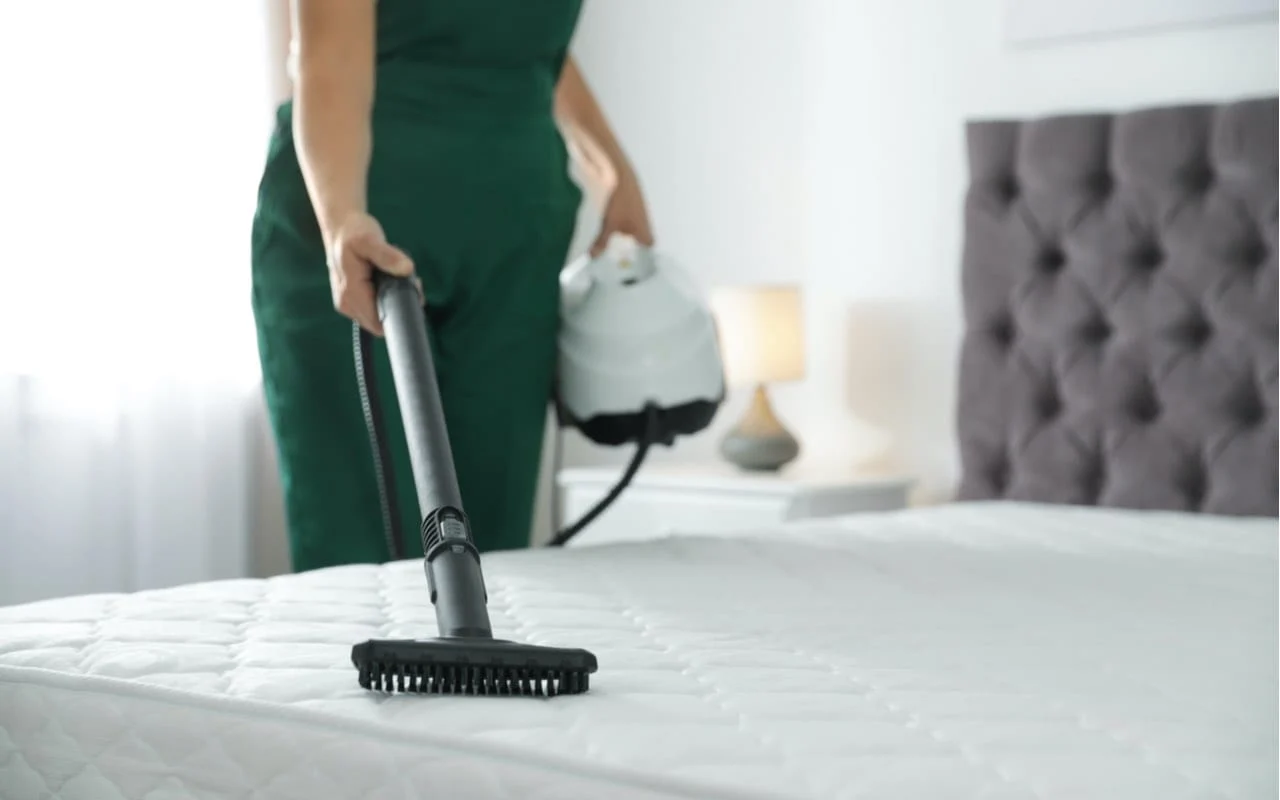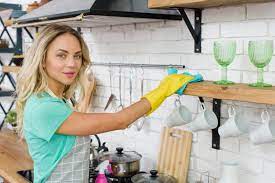
How To Deep Clean Mattresses Tips
How to Deep Clean Mattress and Bedding. In this comprehensive guide, we’ll navigate the realm of deep cleaning for mattresses and bedding, revealing the steps to transform your sleeping sanctuary into a haven of pristine comfort. Whether you’re tackling this task yourself or prefer to enlist professional help, you can book our global clean deep cleaning experts to ensure your mattress and bedding receive the thorough care they deserve.
- Gather Supplies: Start by collecting your cleaning supplies, which may include a vacuum cleaner with an upholstery attachment, baking soda, a mild detergent, a spray bottle filled with water, and a soft brush or cloth.
- Remove Bedding: Strip the bed of all sheets, pillowcases, and mattress protectors. Wash them in hot water to kill dust mites and bacteria.
- Vacuum Thoroughly: Use the upholstery attachment on your vacuum cleaner to thoroughly vacuum the mattress’s surface, paying special attention to seams, crevices, and any stains or spills.
- Spot Clean Stains: For stains, mix a mild detergent with water in a spray bottle and lightly spritz the affected areas. Gently blot the stain with a clean cloth or sponge, working from the outside in to avoid spreading it.
- Deodorize with Baking Soda: Sprinkle a generous amount of baking soda evenly over the entire mattress surface. Let it sit for at least 15 minutes, or longer if possible, to absorb odors and moisture.
- Brush or Vacuum Again: After the baking soda has had time to work, use a soft brush or the upholstery attachment on your vacuum cleaner to remove all the baking soda.
Deep cleaning your mattress and bedding periodically can help extend their lifespan and create a healthier sleeping environment.
The Unseen Culprits: Why Deep Cleaning Matters

The seemingly pristine surface of your bedding masks a hidden world bustling with activity. Beneath the inviting sheets and covers lies a microcosm that plays host to an array of microscopic creatures, including dust mites, skin cells, and allergens. These uninvited inhabitants can trigger allergies, disrupt your sleep, and potentially lead to various health issues. While regular tidying may keep the exterior appealing, it’s the practice of deep cleaning that serves as the ultimate defense against these unwanted invaders.
Delving beneath the surface, a realm of intricacy unfolds. Dust mites, invisible to the naked eye, thrive in the warmth and humidity provided by our bodies as we rest. These minuscule creatures feast on the skin cells we shed, and their waste can contribute to allergies and respiratory problems. Skin cells, which we naturally shed in large quantities during sleep, become nourishment for this hidden population. Additionally, allergens from pets, pollen, and the environment can also find their way into this microcosm, exacerbating sensitivities and causing discomfort. However, by adopting a regimen of deep cleaning – involving regular washing, vacuuming, and sun exposure – you can fortify your bedding against these intruders. Such practices not only maintain the longevity and hygiene of your bedding but also provide a shield against potential sleep disturbances and health repercussions, ensuring a restful sleep environment that promotes well-being.
Detecting the Signs: When Your Mattress Needs Help

Frequent and unrelenting allergies, coupled with mysterious fits of sneezing, or nights spent in restless discomfort, often serve as clear indicators that your mattress is craving a comprehensive and thorough deep cleaning. The very place where you seek solace and rejuvenation might inadvertently become a haven for dust mites, accumulated skin cells, and allergens, all of which can compromise your well-being and sleep quality. These issues can be particularly troublesome for individuals with respiratory sensitivities or allergies.
Considering the timeframe, if your mattress has gallantly soldiered through over a year without experiencing a meticulous deep cleanse, the opportune moment has undoubtedly arrived to bestow upon it the care it so rightfully warrants. Beyond the apparent aesthetic appeal, it’s the unseen ecosystem within the mattress that demands attention. Dust mites, microscopic organisms that feast on our discarded skin cells, can populate and flourish, their presence often contributing to allergic reactions. The accumulation of allergens and debris can further exacerbate these concerns, causing disruptions in your sleep patterns and affecting your overall health.
How to Deep Clean Your Mattress and Bedding Easily

- Assembling Your Arsenal
Before embarking on your cleansing odyssey, arm yourself with the essentials: a vacuum cleaner boasting an upholstery attachment, mild detergent, baking soda, a trusty spray bottle, and soft, clean clothes.
- Bidding Farewell to Bed
Commence the process by gently stripping your bedding – sheets, pillowcases, and mattress covers. This act of liberation allows you to access every crevice and corner of your mattress.
Steps How to Deep Clean Your Mattress and Bedding

- The First Sweep: Vacuuming
Embrace your vacuum’s upholstery attachment to meticulously vacuum every inch of your mattress. Traverse seams, delve into crevices, and conquer corners with unwavering determination.
- Tackling Stains: Spot Cleaning Techniques
For those persistent stains that have weathered the test of time, concoct a gentle solution of mild detergent and water. Dab the stain with a clean cloth soaked in the solution, ensuring not to saturate the mattress.
- A Breath of Freshness: Deodorizing Magic
Harness the power of baking soda by generously sprinkling it across your mattress. Allow it to stand for a minimum of 15 minutes, graciously absorbing lingering odors.
- Battling Stubborn Stains: Treatment Secrets
For the obstinate stains that refuse to yield, a mixture of hydrogen peroxide and baking soda forms a formidable paste. Gently scrub the stain with this concoction and a soft brush.
- Allowing Breathing Room: Drying Methods
Post-cleaning, grant your mattress the gift of time. Allow it to air dry entirely before cloaking it in fresh bedding. The embrace of sunlight can aid in the expulsion of bacteria and odors.
Rejuvenating Pillows and Bedding

- Pillow Rejuvenation Rituals
Extend your care to the often-neglected pillows. Bestow upon them daily fluffing and periodic pillowcase changes. Consult care labels for personalized rejuvenation directives.
- Laundering Bedding with Care
The nurturing touch of a washing machine restores vitality to sheets, pillowcases, and mattress covers. Embrace the warmth of a gentle cycle and a mild detergent for optimal care.
- Sustaining the Serenity:
To perpetuate the effects of your deep cleaning endeavor, consider employing a mattress protector, adhering to a regular vacuuming routine, and periodically rotating your mattress.
Conclusion
Within the realm of slumber, cleanliness is paramount. Deep cleaning for mattresses and bedding signifies a dedication to elevating your sleep haven into a realm of purity and comfort. Through this act of care, you embark on a journey of enhanced well-being and tranquil rest.
FAQS
It is advisable to embark on a deep cleaning journey for your mattress at least twice a year. However, personal considerations such as allergies and preferences may influence the frequency.
While standard household cleaning agents can be effective, it’s prudent to opt for mild detergents to prevent potential damage to the mattress fabric and to safeguard your skin.
Sunlight possesses natural disinfecting properties that can aid in killing bacteria and eliminating odors. However, exercise caution to prevent overexposure to direct sunlight.
Employ hypoallergenic mattress and pillow covers, establish a regular bedding laundering routine, and diligently vacuum your mattress and surrounding area.
Indeed, a mattress protector serves as a guardian against dirt and allergens, subsequently reducing the frequency of deep cleaning sessions.

















































